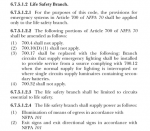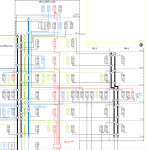- Location
- Illinois
- Occupation
- retired electrician
The four list items in 517.26 were added for the 2020 code. Here is the substantiation for that addition.Right- on the basis that the building will be evacuated. Or people will move to another location within a large building. As such there must be continuity of electrical service to fire alarm panel, egress lights, and command intercom. Ditto for the fire pump, despite being a separate branch.
What life safety would there be if all the exits signs and stairwells went dark? I can't find my way out...
Again, any change in this would rest with the technical committee for NFPA 99. The CMP for the NEC does not have the authority to make the change.As the Chair of NFPA 99 Electrical Systems Committee (HEA-ELS), I am submitting this proposal to improve the correlation between NFPA 99 and NFPA 70. The substantiation of this proposal is as follows: It has been established by the NFPA Standards Council that NFPA 99 has jurisdiction over performance requirements for electrical systems in health care facilities while NFPA 70 has jurisdiction over the installation requirements. The proposed addition is the result of the 99 HEA-ELS TC agreeing that the life safety branch is required to conform to Article 700 with the exception of several performance requirements. Section 700.4 speaks to capacity of the system which NFPA 99 already addresses in detail. Section 700.10(D)(1) can possibly impose fire protection requirements in excess of what a building code might require for the rest of the structure. Section 700.17 is slightly modified and 700.32 is also identified as not applying due to the documented decision that selective coordination is a performance issue under the jurisdiction of NFPA 99.











